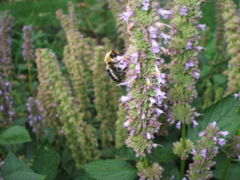Agastache
| Agastache subsp. var. | Giant hyssop, Mexican hyssop | |||||||||||||||||||||||||||||||||||||||||||||||||||||||
|---|---|---|---|---|---|---|---|---|---|---|---|---|---|---|---|---|---|---|---|---|---|---|---|---|---|---|---|---|---|---|---|---|---|---|---|---|---|---|---|---|---|---|---|---|---|---|---|---|---|---|---|---|---|---|---|---|

|
|
| ||||||||||||||||||||||||||||||||||||||||||||||||||||||
| ||||||||||||||||||||||||||||||||||||||||||||||||||||||||
Blue, purple or yellow/orange flowers come on spikes in the summersn. Often look similar to Salviassn.
Agastache, is a genus of 9–12 species of perennial herbs in the family Lamiaceae, native to eastern Asia (one species) and North America (the rest).
Most species are very upright, 0.5–3 m tall, with stiff, angular stems clothed in toothed-edged, lance shaped leaves ranging from 1–15 cm long and 0.5–11 cm broad depending on the species. Upright spikes of tubular, two-lipped flowers develop at the stem tips in summer. The flowers are usually white, pink, mauve, or purple, with the bracts that back the flowers being of the same or a slightly contrasting color. Leaf tips can be eaten and made into teas.
Cultivation
They are easily grown in moist, well-drained soil and prefer a sunny position. Winter hardiness varies; the hardiest is A. foeniculum, hardy to USDA plant hardiness zone 1 in the north of its range; A. nepetoides, A. rugosa, A. scrophulariifolia and A. urticifolia are hardy to zones 3–5 in the northern parts of their ranges. Popular cultivars include A. cana 'Heather Queen'.
Propagation
Propagate from seed or cuttings.
Pests and diseases
- Do you have pest and disease info on this plant? Edit this section!
Species
- Specieswp
- Agastache aurantiaca. Orange Hummingbird Mint. Mexico, SW USA (Arizona, New Mexico).
- Agastache barberi
- Agastache breviflora. TransPecos giant hyssop. Northern Mexico (Chihuahua, Sonora), SW USA (Arizona).
- Agastache cana. Texas Hummingbird Mint. SW USA (New Mexico, western Texas).
- Agastache foeniculum. Giant or Anise Hyssop. From Arctic Canada to Colorado and Wisconsin.
- Agastache mexicana. Mexican Giant Hyssop. Central Mexico.
- Agastache nepetoides. Eastern North America from southern Ontario and southern Quebec south to Georgia.
- Agastache pallida (syn. A. barberi). Northern Mexico (Chihuahua, Durango, Sonora), southwestern USA (Arizona).
- Agastache pallidiflora. Southwestern USA (New Mexico, western Texas).
- Agastache pringlei. Northern Mexico (Chihuahua), southwestern USA (New Mexico).
- Agastache parvifolia. California.
- Agastache rugosa. Korean Mint. Southeastern Russia (Primoriye), Japan, China, Korea, Taiwan, Vietnam.
- Agastache rupestris. Threadleaf giant hyssop or Licorice Mint. Arizona, New Mexico.
- Agastache scrophulariifolia. Eastern North America from southern Ontario south to Georgia.
- Agastache wrightii. Southwestern USA (Arizona, New Mexico).
- Agastache urticifolia. Western North America from British Columbia south to California and Nevada.
Gallery
If you have a photo of this plant, please upload it! Plus, there may be other photos available for you to add.
-
photo 1
-
photo 2
-
photo 3
References
External links
- w:Agastache. Some of the material on this page may be from Wikipedia, under the Creative Commons license.
- Agastache QR Code (Size 50, 100, 200, 500)
